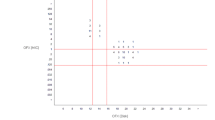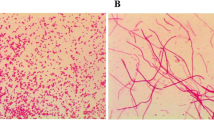Abstract
Sixteen children (7 males, 9 females) aged 0.1 to 9.5 years (mean 3.6 years) who were hospitalized for severe salmonella infection were treated with conventional antibiotics. In nine children disappearance of fever and bloody diarrhea was obtained 2 to 4 days after the beginning of antibiotic therapy. Although the antibiotic administered was active against the pathogen, after 4 to 8 days the seven other children experienced clinical failure of the initial therapy, with a temperature of over 39 °C, bloody diarrhea and positive stool culture in all cases. The sevenSalmonella strains isolated (1S. typhi, 1S. paratyphi B, 2S. enteritidis, 3S. typhimurium) were all sensitive to ampicillin, cotrimoxazole and pefloxacin. These seven children were then given 12 mg/kg/day of pefloxacin orally for 7 days. Apyrexia and complete resolution of diarrhea were obtained within 1 to 3 days in all cases without side effects. Trials are needed to determine the safety and toxicity of quinolones in children, however short-term therapy with pefloxacin could be useful in children with severe invasive salmonellosis after failure of conventional antibiotic therapy.
Similar content being viewed by others
References
Asperilla MO, Smego RA, Keith Scott L: Quinolone antibiotics in the treatment of salmonella infections. Reviews of Infectious Diseases 1990, 12: 873–889.
Pocidalo JJ: Use of fluoroquinolones for intracellular pathogens. Reviews of Infectious Diseases 1989, 11, Supplement: 979–984.
Chang HR, Uladoianu IR, Pechere JC: Effects of ampicillin, chloramphenicol, pefloxacin and trimethoprim onSalmonella typhi within human monocyte-derived macrophages. Journal of Antimicrobial Chemotherapy 1990, 26: 689–694.
Hornick RB: Salmonella infections. In: Feigin RD, Cherry JD (ed): Textbook of pediatric infectious diseases. Saunders, Philadelphia, 1987, p. 673–682.
Schaad UB, Wedgwood-Krucko J: Nalidixic acid in children: retrospective matched controlled study for cartilage toxicity. Infection 1987, 15: 165–168.
Schaad UB, Stoupis C, Wegwood J, Tschaeppeler H, Vock P: Clinical, radiologic and magnetic resonance monitoring for skeletal toxicity in pediatric patients with cystic fibrosis receiving a 3-month course of ciprofloxacin. Pediatric Infectious Disease Journal 1991, 10: 723–729.
Bryan JP, Rocha H, Scheld WH: Problems in salmonellosis: rationale for clinical trials with newer β-lactam agents and quinolones. Reviews of Infectious Diseases 1986, 8: 189–207.
Author information
Authors and Affiliations
Rights and permissions
About this article
Cite this article
Gendrel, D., Raymond, J., Legall, M.A. et al. Use of pefloxacin after failure of initial antibiotic treatment in children with severe salmonellosis. Eur. J. Clin. Microbiol. Infect. Dis. 12, 209–211 (1993). https://doi.org/10.1007/BF01967114
Issue Date:
DOI: https://doi.org/10.1007/BF01967114




